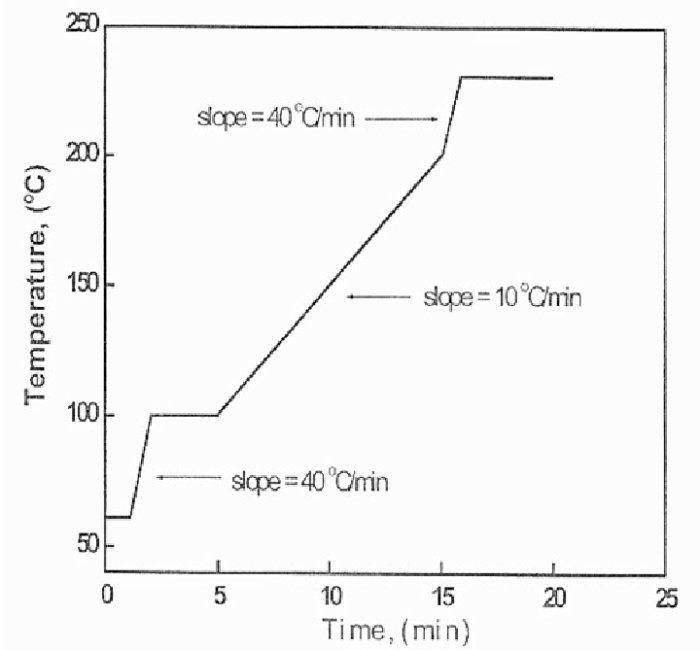What are the advantages of temperature programming in gas chromatography? Temperature programming is a technique used in gas chromatography (GC) to improve the separation of compounds, enhance peak shape and resolution, increase sensitivity and detection limits, reduce analysis time and improve efficiency, and optimize selectivity and specificity.
This article will explore the advantages of temperature programming in GC and provide examples of its applications.
Advantages of Temperature Programming in Gas Chromatography: What Are The Advantages Of Temperature Programming In Gas Chromatography

Temperature programming is a technique employed in gas chromatography (GC) that involves varying the temperature of the column during the separation process. This dynamic temperature adjustment offers numerous advantages, enhancing the analytical capabilities of GC and enabling more efficient and informative analyses.
Improved Separation of Compounds
Temperature programming allows for the optimization of separation conditions by gradually increasing the temperature of the column. This gradient elution technique improves the separation of compounds with different boiling points. As the temperature increases, compounds with lower boiling points elute first, followed by those with higher boiling points.
This controlled temperature change ensures that compounds are separated based on their volatility, resulting in better resolution and peak separation.
For example, in the analysis of a complex mixture of hydrocarbons, temperature programming can be used to separate compounds with similar boiling points. By gradually increasing the temperature, the separation of these compounds is enhanced, allowing for their identification and quantification.
Enhanced Peak Shape and Resolution
Temperature programming contributes to improved peak shape and resolution by minimizing peak tailing. Peak tailing occurs when the trailing edge of a peak is broader than the leading edge, resulting in a distorted peak shape. This can lead to difficulties in peak integration and quantification.
Temperature programming addresses this issue by optimizing the elution conditions for each compound. By controlling the temperature gradient, the rate of elution is adjusted, reducing peak tailing and improving peak shape.
The improved peak shape and resolution achieved through temperature programming enhance the overall quality of chromatographic data. Well-defined peaks with minimal tailing facilitate accurate peak integration and quantification, leading to more reliable and reproducible analytical results.
Increased Sensitivity and Detection Limits
Temperature programming can enhance the sensitivity and detection limits of GC by optimizing the conditions for analyte detection. By controlling the temperature gradient, the analytes of interest can be eluted at a temperature where they exhibit maximum detector response. This increased sensitivity allows for the detection of trace levels of analytes that may otherwise be missed under isothermal conditions.
For example, in environmental analysis, temperature programming can be employed to improve the detection of volatile organic compounds (VOCs) in air samples. By optimizing the temperature gradient, the sensitivity of the GC-MS system can be increased, enabling the detection of VOCs at very low concentrations.
Reduced Analysis Time and Improved Efficiency
Temperature programming enables faster analysis times and improved efficiency in GC. By gradually increasing the temperature of the column, the elution of compounds is accelerated. This reduction in analysis time allows for increased sample throughput and improved laboratory productivity.
The concept of “fast chromatography” utilizes temperature programming to achieve rapid separations. By employing steep temperature gradients, the analysis time can be significantly reduced while maintaining good separation efficiency. This approach is particularly beneficial in applications where time is a critical factor, such as in industrial quality control or process monitoring.
Optimization of Selectivity and Specificity, What are the advantages of temperature programming in gas chromatography
Temperature programming provides a means to optimize the selectivity and specificity of GC separations. By controlling the temperature gradient, the elution order of compounds can be manipulated. This allows for the separation of compounds that may coelute under isothermal conditions.
For instance, in the analysis of pharmaceuticals, temperature programming can be used to separate enantiomers or diastereomers that have similar chemical properties. By carefully adjusting the temperature gradient, the separation of these compounds can be achieved, enabling their identification and quantification.
Applications of Temperature Programming in Gas Chromatography
Temperature programming has been successfully employed in a wide range of applications across various scientific disciplines. Here are a few examples:
| Application | Sample Type | Temperature Program | Benefits |
|---|---|---|---|
| Environmental analysis | Air samples | Gradient from 40°C to 250°C | Improved detection of VOCs |
| Forensic science | Drug analysis | Gradient from 50°C to 300°C | Separation of complex drug mixtures |
| Pharmaceutical analysis | Drug metabolites | Gradient from 100°C to 350°C | Enhanced selectivity for enantiomer separation |
| Food analysis | Flavor compounds | Gradient from 50°C to 200°C | Improved resolution of volatile flavor compounds |
| Petrochemical analysis | Hydrocarbons | Gradient from 70°C to 300°C | Separation of hydrocarbons with similar boiling points |
FAQ Insights
What is temperature programming?
Temperature programming is a technique used in gas chromatography to vary the temperature of the column during the analysis. This can be done to improve the separation of compounds, enhance peak shape and resolution, increase sensitivity and detection limits, reduce analysis time and improve efficiency, and optimize selectivity and specificity.
What are the advantages of temperature programming?
The advantages of temperature programming include improved separation of compounds, enhanced peak shape and resolution, increased sensitivity and detection limits, reduced analysis time and improved efficiency, and optimized selectivity and specificity.
How is temperature programming used in gas chromatography?
Temperature programming is used in gas chromatography to improve the separation of compounds, enhance peak shape and resolution, increase sensitivity and detection limits, reduce analysis time and improve efficiency, and optimize selectivity and specificity.

